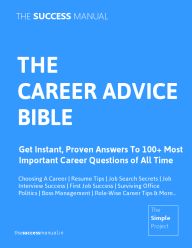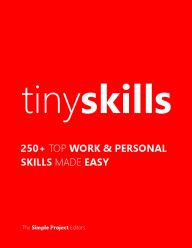On February 16, 2025 By thesuccessmanual Topic: Remarkable, Simpleguide
This guide belongs to 100 Ways To Be Being Remarkable Series, a special project that brings you business and self-development advice from The Success Manual.
THE BEST INNOVATION ON THE INTERNET HAS BEEN DONE BY A SINGLE PERSON, A DUO OR A VERY SMALL GROUP.
Examples: Google, Yahoo, Wikipedia, Youtube, Del.icio.us, Metafilter, Craigslist
Ignore those who try to put you down.
- Guy Kawakasi
A SIMPLEGUIDE TO BE CREATIVE
1. Try anything out of the ordinary.
2. Take Edison’s Hiring Test
Before he hired a research assistant, Edison would invite the candidate over for a bowl of soup. If the person seasoned the soup before testing it, he would not be hired. Edison wanted people who consistently challenged assumptions and tried different things, not people who had so many built- in assumptions that they would presume the soup was improperly seasoned.
3. How to challenge assumptions
One way to do that is to list your assumptions about a subject. Next, Write down the opposite of each assumption. Ask yourself: How to accomplish each reversalList as many useful viewpoints as you can. Do this ‘challenge’ before you start out on any project. For example - starting a business.
4. Waste nothing. Record all you’ve learnt.
Learn from failed experiments. (Corollary : You will also discover many things that didn’t work). You can use ideas from failed projects elsewhere.
5. Record your ideas.
6. Comb out knowledge
From books, periodicals, on-line resources, even from source other than your field.
8. You can use other people’s ideas
And do something else with them.
9. Brainstorming
Try the Scamper Method. Scamper is short for Substitute, Combine, Adapt, Magnify and Modify. Eliminate, rearrange, reverse, or isolate the subject you want to think about and browse the checklist of Scamper questions to see what new ideas and thoughts emerge. You will find that SCAMPER is the real idea- popping machine.
10. Explore
Whenever you find something interesting, explore it intellectually, before you apply your emotions and prejudices. To explore a subject with your intellect, you need to will yourself to direct your attention in different ways.
11. PMI
‘Plus/Minus/Interesting’ or PMI. You will find about PMI further in this section. Notice that with PMI, one of 3 things happen.
1. You don’t change your mind,
2. You may change your mind about the idea, or
3. You may move from an ‘Interesting’ aspect of the idea to another idea.
PMI forces you to explore every aspect of your subject.
12. Start acting like you are creative.
Suppose that you want to be an artist, start behaving like an artist by painting every day. You have to work on it continuously.
PCD
Possibilities, Consequences, Decision
The three greatest words for scientists: “I don’t know.”
– Anon
More Creativity Tips
Wake up your right brain. The right brain is your creativity center. Because the right brain hemisphere controls the left side of your body, you can activate this creativity center by breathing out of only your left nostril, jumping up and down on your left foot, and writing with your left hand. You can also do something artistic such as drawing, playing a musical instrument, creating mandalas, and so on. In addition, meditation stimulates the right brain hemisphere.
Use the Random Word Technique. Start by writing down a description of your problem, challenge or opportunity. Then, choose a random word–you can open a dictionary and choose the word your eyes focus on–and write down any associations that it makes you think of. After jotting down a number of words or short phrases, review your associations and your problem statement, and determine if you could adapt any of your associations to your current problem.
Create a mindmap. Write a topic heading in the center of a white piece of paper and then start writing related ideas on branches linked to the main topic; then add more ideas as sub-branches. Create as many levels of ideas as you want. Use different colors and add illustrations.
Disrupt your habitual thought patterns. Take a different route to work, try food you’ve never eaten before, listen to a music genre you normally don’t listen to, read different magazines, and so on. Explore something new, try something you’ve always wondered about.
Re-connect with your inner child. Buy crayons and a coloring book-the big thick kind filled with all kinds of images that you loved as a child–and sit down for an afternoon of coloring. It’s OK if you color outside the lines. Play jacks, draw with chalk on the sidewalk, build a fortress–or anything else that catches your fancy–with Lego’s, go to the playground and climb on the swings . . .
Break it down. Break a problem down into it’s smallest components and rebuild it from the ground up, questioning at every step whether that’s the best way to do it.
Ask lots of questions. Constantly ask: “What if . . .”; “Why not . . .”; “How else can this be done?”; “How can this be improved?”; “What other alternatives are there?”; “What am I missing?” . .
Go Back to Basics. Pick up a pen or pencil and paper.
Focus. Great creative breakthroughs usually happen only after we have focused sufficient attention on our subject matter.
Set a quantity quota. What if you had to come up with twenty different ways of solving the problemThomas Edison applied the concept of an “idea quota” in his life.
Make it visual. Learn to draw, even if it’s very rudimentary sketches.
Practice being in a receptive state of mind. Instead of constantly having the television on, listening to your ipod, and surrounding yourself with noise and other distractions, practice being in a relaxed, contemplative state of mind.
This state of mind is the one most conducive to allowing creative thoughts to slip into your mind.
THE CREATIVITY CHECKLIST
A checklist for creating/inventing new products:
1. Opposite
2. Magnify/Minimize
3. Adaptation
4. Exaggeration
5. Addition/Subtraction
6. Time Frames
7. Packaging that sells
8. Specific Solutions
9. Combining
10. Re-arranging
11. General Purpose vs. Special Purpose
12. Coined Terminology [Like, the Web –WWW]
13. Symbols [like, Brands]
14. Technology
- Anon
SIX WAYS TO BOOST BRAINPOWER
1. Exercise
2. Diet Stimulants
3. Video Games
4. Music
5. Meditation
- Sciam.com
If you liked this article, please bookmark it on Delicious or share on Twitter. Thanks, friends. Follow us on Twitter.
We don't recommend any other guide than our very own The Success Manual - Encyclopedia of advice to 130 most important skills.

